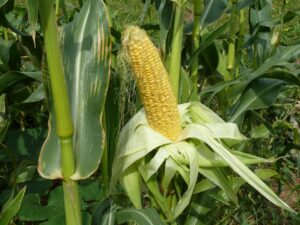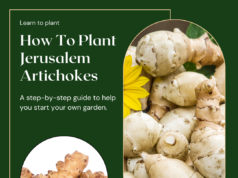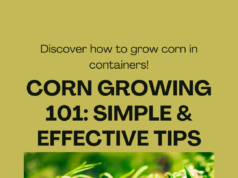
Are you ready to embark on a corn-growing adventure? Get your gardening tools ready because in this guide, we’ll take you through the step-by-step process of planting and caring for corn.
From choosing the right corn varieties to harvesting and storing your sweet corn, we’ve got you covered.
So, get ready to dive into the world of growing your own corn and experience the rewarding journey of watching your crop thrive.
Let’s get started!
Key Takeaways
– Corn is a versatile crop that can be grown in a home garden or a backyard garden.
– To successfully grow corn, it is important to plant the seeds directly in the garden, in blocks of short rows, and at least one inch deep.
– Corn is a wind-pollinated plant, so it is recommended to grow only one variety of corn to prevent cross-pollination.
– Corn is a hungry plant that requires regular care, including watering, fertilizing, and protecting it from common pests such as corn borers and corn earworms.
Choosing the Right Corn Varieties
Are you wondering which corn varieties are the best to choose for your home garden? When it comes to planting and caring for corn, choosing the right corn varieties is essential.
There are many different types of sweet corn varieties available, each with its own unique characteristics. Some popular choices include the Golden Bantam, Silver Queen, and Honey and Cream. The Golden Bantam is known for its deliciously sweet flavor, while Silver Queen is a popular choice for its larger ears and tender kernels. Honey and Cream, as the name suggests, offers a combination of sweet and creamy flavors.
Consider your preferences and the growing conditions in your area when selecting corn varieties for your garden. By choosing the right corn varieties, you can ensure a successful and flavorful harvest.
Preparing the Soil for Planting
To ensure optimal growth and yield, it’s crucial to properly prepare the soil before planting corn in your home garden. Here are three important steps to follow:
1. Clear the area: Remove any weeds, rocks, or debris from the planting site. This will create a clean space for your corn plants to grow without competition for nutrients and water.
2. Amend the soil: Test your soil to determine its pH level and nutrient content. Adjust the pH if necessary and add organic matter, such as compost or well-rotted manure, to improve soil fertility and drainage.
3. Determine corn plant spacing: Corn plants need plenty of room to grow and develop properly. Space the rows about 30 inches apart, with each corn plant placed about 12 inches apart within the row.
Planting Corn Seeds
Now that you have prepared the soil for planting, it’s time to sow your corn seeds directly in the garden, ensuring a successful and abundant harvest. To plant corn seeds, follow this guide to growing corn.
Start by creating rows in your garden bed, spacing them about 30 inches apart. Dig small holes about 1 inch deep and place a corn seed in each hole. Cover the seeds with soil and water gently.
It’s important to plant corn seeds in blocks rather than single rows to encourage proper pollination. Corn is wind-pollinated, so planting in blocks ensures that the pollen can easily reach the silks.
Now that your corn seeds are in the ground, it’s time to provide proper watering and fertilization to support their growth.
Providing Proper Watering and Fertilization
After planting your corn seeds, it’s important to ensure proper watering and fertilization for optimal growth. Here’s what you need to know:
1. Watering: Corn plants need consistent moisture throughout the growing season. Water deeply and regularly, providing about 1 inch of water per week. Make sure the soil is evenly moist, but not waterlogged, as this can lead to root rot.
2. Fertilization: Corn is a heavy feeder and requires adequate nutrients to thrive. Before planting, incorporate a balanced fertilizer into the soil. Once the plants are established, side-dress them with nitrogen-rich fertilizer every 3-4 weeks. This will promote healthy growth and higher yields.
3. Home garden care: In your home garden, ensure that the corn plants have enough space to grow. Plant them in blocks rather than single rows to aid in pollination. Also, be mindful of weeds and remove them regularly to reduce competition for nutrients and water.
Managing Common Corn Pests
When managing common corn pests, it’s important to be proactive in preventing and controlling infestations. Corn earworms are one of the most common pests that can damage your corn crop. To prevent these pests, you can use sticky traps or apply insecticides specifically designed for corn.
Regularly inspect your corn patch for signs of pest infestation, such as chewed leaves or corn silks. If you find any pests, take immediate action to control them.
Additionally, practicing good crop rotation and maintaining a clean garden bed can help prevent pests from establishing in your corn growing area.
By managing common corn pests effectively, you can ensure a healthy harvest of sweet corn.
Now, let’s move on to the next section and discuss caring for growing corn plants.
Caring for Growing Corn Plants
To ensure the health and success of your growing corn plants, it’s essential that you provide proper care and attention throughout their growth. Here are three important steps to caring for your corn plants:
1. Watering: Corn plants require consistent moisture, especially during the growing season. Water them deeply and regularly, ensuring that the soil is evenly moist. Avoid overwatering, as it can lead to root rot.
2. Fertilizing: Sweet corn is a hungry plant and benefits from regular fertilization. Use a balanced fertilizer to provide essential nutrients and promote healthy growth. Apply fertilizer when planting and again when the corn reaches knee height.
3. Harvesting: The ultimate reward of growing corn is enjoying the delicious corn on the cob. Harvest sweet corn varieties when the kernels are plump and fully formed. To test for ripeness, peel back the husk and pierce a kernel with your thumbnail. If a milky liquid is released, the corn is ready to harvest.
Enjoy the fruits of your labor!
Harvesting and Storing Corn
To harvest and store corn, you’ll need to follow a few important steps.
First, wait until the sweet corn is ready to harvest. You can tell it’s ready when the kernels are plump and the ear of sweet corn feels full.
Next, harvest the corn by firmly gripping the ear and pulling it downward. Be careful not to damage the stalk or the neighboring ears of corn.
After harvesting, it’s important to store the corn properly to maintain its freshness. Remove the husks and silk from the ear of corn, then place it in a plastic bag and store it in the refrigerator.
Alternatively, you can blanch the corn and freeze it for later use.
Extending Your Corn Harvest
To extend your corn harvest, you can employ various strategies to ensure a continuous supply of fresh corn throughout the growing season. Here are three effective tactics to help you maximize your harvest:
1. Plant early: By planting your corn seeds as soon as the soil is warm enough, you can give your corn a head start and allow it to grow and mature before the end of the season.
2. Plant another round: Once your first harvest is complete, don’t be afraid to plant another batch of corn seeds. This will stagger the growth and allow you to enjoy fresh corn for a longer period.
3. Plant roots deep: Corn can grow deep roots, so make sure to provide enough space and nutrients for them to thrive. Deep roots will help your corn plants access water and nutrients, resulting in healthier and more productive plants.
By implementing these strategies, you can extend your corn harvest and enjoy a bountiful supply of delicious corn throughout the season.
Now, let’s move on to some tips for success in growing corn.
Tips for Success in Growing Corn
Maximize your corn yield by implementing these essential tips for successful corn growing.
When planning to grow corn in your backyard garden, it’s important to be aware of common corn pests and take preventive measures.
Follow a guide to growing corn to ensure that you plant at the best time. The ideal time for planting corn is when the soil has warmed up and all chances of frost have passed.
Be mindful of common corn pests such as corn borers and corn earworms, and take necessary steps to protect your crop.
FAQ
Q: What is the best time to plant sweet corn?
A: The best time to plant sweet corn is typically in late spring or early summer when the soil has warmed up and the danger of frost has passed.
Q: How do I plant corn seeds?
A: To plant corn seeds, prepare the soil by removing any weeds and tilling it to a depth of at least six inches. Create planting furrows spaced about 12 inches apart and about one inch deep. Place the corn seeds about eight to twelve inches apart in the furrows and cover them with soil.
Q: How do I care for corn plants?
A: To care for corn plants, water them regularly, making sure the soil stays consistently moist. Fertilize the plants every 3-4 weeks, starting when they are about 12 inches tall. Keep the area around the plants free from weeds, as they can compete for nutrients. Additionally, provide support for tall corn varieties by staking or tying them to prevent them from lodging.
Q: What are the common pests that affect corn plants?
A: The common pests that affect corn plants include corn earworms, armyworms, cutworms, and corn borers. These pests can cause damage to the leaves, stalks, and ears of the corn plant.
Q: How can I prevent or control corn pests?
A: To prevent or control corn pests, you can use natural methods such as planting companion plants that repel pests, applying organic insecticides, and practicing crop rotation. Additionally, keeping the planting area clean and free from debris can help reduce the likelihood of pest infestations.
Q: How do I know when sweet corn is ready to harvest?
A: Sweet corn is ready to harvest when the ears have fully developed and the corn silk has dried and turned brown. To test for ripeness, pull back the husk and pierce a kernel with your fingernail – if a milky substance comes out, the corn is ready to be picked.
Q: Can I grow sweet corn in containers?
A: Yes, you can grow sweet corn in containers. However, make sure to choose a container that is large enough to accommodate the corn’s root system and provides good drainage. Additionally, select dwarf or bush varieties of sweet corn that are more suitable for container gardening.
Q: How can I extend my sweet corn harvest?
A: To extend your sweet corn harvest, you can stagger the planting of your corn seeds. Plant a portion of the seeds every two weeks for a continuous harvest throughout the growing season. This method ensures that not all the corn plants will be ready for harvest at the same time.
Q: What are the different varieties of sweet corn?
A: There are several different varieties of sweet corn available, including standard varieties, bi-color varieties, and super sweet varieties. Each variety has its own unique taste, texture, and cooking characteristics.
Q: How should I care for the roots of the corn plants?
A: It is important to take care of the roots of the corn plants by watering them deeply and regularly. Make sure the soil is well-drained to prevent waterlogged roots, as this can lead to poor growth and disease. Avoid disturbing the roots when cultivating or weeding around the plants.
Conclusion
Congratulations on completing your corn-growing adventure! By following this guide, you have gained the knowledge and skills needed to successfully plant and care for corn.
Just like a summer sunset painting the sky with vibrant colors, your corn crop will bring beauty and abundance to your garden.
Remember to share your freshly harvested corn with friends and family, spreading the joy of homegrown goodness like a warm summer breeze.
Happy growing!
















